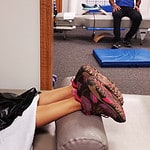Introduction
Box step-ups are a great low-impact exercise. They can help reduce knee arthritis pain. You step up and down on a low-level box or platform. It keeps the knee joint in a safe motion. Doing this exercise can build strength and range of motion in the knees. It also reduces joint pain and inflammation.
Want to know more? This article has the basics. Plus, it covers the benefits and how to do box step-ups correctly:
- Keep the knee joint in a safe motion.
- Build strength and range of motion in the knees.
- Reduce joint pain and inflammation.
Overview of box step-ups
Box step-ups are a low-impact exercise that can help people with knee arthritis. Step up, then down, one foot at a time. This can strengthen the muscles of the hips, thighs, and calves, which supports the knee joint.
No pain or discomfort to an already inflamed joint. Also, box step-ups improve balance and coordination. Plus, it can help heart function and burn calories.
- Find a platform or box size that best suits your needs and abilities. Test it out first.
- Wear supportive shoes for maximum comfort.
- Start slowly and add reps as your muscles get used to the movement.
Benefits of box step-ups for knee arthritis
Box step-ups are great for people with knee arthritis. They can help reduce pain and improve mobility. Use bodyweight or weights for best results. Box step-ups target the quadriceps and gluteal muscles. Plus, they strengthen the stabilizing muscles in your hips, legs, and core. This protects your knees from injury.
The knee joint is a hinge made of cartilage and bone. It moves flexibly in one direction. Strong leg muscles make it able to handle exercise and activities like running, squatting, jumping, and kneeling. Weak leg muscles, though, increase your risk for osteoarthritis. That’s why box step-ups are important for maintaining healthy joints.
Variations of step-ups are endless. Try:
- forward stepping with two feet onto a higher surface, then stepping back down with one foot.
- alternate feet while advancing across surfaces of varying heights.
Use your imagination and get low-impact cardio benefits, plus improved strength and balance. All while reducing pain related to chronic conditions like osteoarthritis.
Preparation
Check with your doctor or physical therapist first! Box step-ups are great for those with knee arthritis. But, there are some important tips to remember. For safe and effective box step-ups, preparation is key. Here’s a few things to keep in mind:
- Maintain a straight posture throughout the exercise.
- Keep your abs tight and your head and chest up.
- Keep your feet hip-width apart and your toes pointing forward.
- Maintain an even weight distribution on both feet.
- Use a box or step that is the appropriate height.
- Do not rush the movement.
Choosing the right box
When picking a box for step-ups, there are a few things to look out for:
- It needs to be tall enough so when you reach the peak of the step-up, your knee is bent (90 degrees is perfect).
- Make sure it’s solid and steady.
- It should also be the right thickness – too thick can get in the way of movement.
Always check for any cracks or splintering before use. Safety must be taken into account to make sure you don’t get injured. Beginners should start with a small box, 8 inches or lower. As you progress, switch up with taller boxes and other props to make the exercise more challenging.
Warming up before the exercise
It’s essential to warm up your body before exercise. This helps you both mentally and physically. It sends more oxygen and nutrients to active tissues, so they can work harder and with fewer injuries. It also reduces muscle soreness post-workout.
Start off with light intensity for a few minutes (5-10). Then, stretch the muscles you’ll use during exercise. Increase the intensity to 70-75% of your max heart rate or talk while exercising. Jogging/running is best if your activity includes running. Do these exercises in dynamic form; move through each stretch slowly.
Then, do some drills related to your sport, like passing drills or shooting drills in soccer. Don’t do this for more than 10 minutes. After that, move on to more intense exercises like sprints or interval training. Lastly, don’t forget to cool down!
Technique
Box Step-Ups are a fab way to get fit without stressing your knees if you have arthritis. It’s essential to get the technique right for the best results. Here’s how to do it correctly:
- Stand in front of a box.
- Place your foot on the box.
- Push off your toes and step up.
- Make sure you keep your back straight.
- Jump down and repeat.
Enjoy your well-deserved workout!
Step-by-step instructions
Brewing great coffee requires attention to detail. Start with quality beans, the right grind size and amount. Follow instructions carefully. It takes practice, but with experimentation you can learn to make consistently delicious coffee.
Grind beans with care. Measure the right amount for your taste. The finer the grind, the more flavor you extract. Too fine and it can clog filters. Not fine enough and it will be weak.
Heat water to 190-200°F. Different brewing methods require different temperatures. Adjust heat if needed.
Put grounds into filter, evenly distributed. Gently press down.
Wet the grounds by pouring twice the desired volume of hot water. Wait 20-30 seconds, then add the rest of the water. Take no more than 10 minutes.
Set the timer for desired strength and wait. Remove filter and discard grounds. Move carafe from brewer or keep warm. Clean carafe after each use.
Tips for proper form
Brewing coffee correctly is key for the perfect cup! This isn’t just to get a yummy flavour, but also to keep your equipment clean and safe. Follow these tips to make sure you get a delicious cup each time:
- Grind: Get the most out of your beans by having a consistent grind size. Uniform pieces means even extraction and full flavour potential.
- Cleanliness: Keeping your brewing gear clean is important for flavour and safety. Coffee oils can build up, causing taste issues and unclean cups. Clean your grinder and brewer regularly with suitable solutions or brushes!
- Water temperature: Heat affects the final flavour. Use hot water, not boiling. Too hot and your brew could be bitter or taste burnt.
- Timing: Find your perfect ratio of coffee to water by experimenting. Pay attention to how long it steeps, and follow your brewing methods guidelines to avoid over-extraction or under-extraction! This ensures a balanced blend each time.
Variations
Box step-ups come in various forms. Each targets a different muscle group, making your workout more effective. Quads, glutes, hamstrings, and calves all benefit from box step-ups – great for knee arthritis! It’s essential to know which variation works best. Let’s explore the different types of box step-ups!
Adding weights
Once you ace the form and basic box step-up, add weights to boost resistance. Holding hand weights (2-3 lbs) is a great start. For extra resistance, use ankle weights too.
When using hand weights, ensure your form stays proper when tired. Lean forward slightly, tighten abs, and keep good posture. This helps protect ACLs and rotator cuffs.
For ankle weights, pick ones with adjustable straps. Begin with a light weight and build up as muscle conditioning improves. Secure the ankle weight during exercise to avoid any instability which can cause injury.
Adding resistance bands
Try using resistance bands in your workouts for a new challenge! Resistance bands are great for strength training, stretching, balance and mobility exercises, as well as adding resistance to yoga poses. They’re lightweight and portable, making them easy to take anywhere.
Different types of resistance bands come in varying levels of strength. Flat bands with handles on either end provide light/moderate resistance when stretched. Tube bands with foam handles offer adjustable resistance and are great for doing upper-body exercises like chest presses or bicep curls. Mini-loop bands are small circular rings that fit around arms/legs and target muscle groups like glutes or core muscles. Accessories like door anchors and handles can also be added for extra versatility.
Using resistance bands in your workout brings lots of benefits – improved range of motion, increased muscular endurance, etc. – making it an invaluable piece of fitness equipment.
Safety Considerations
Box Step-Ups can be helpful for people with knee arthritis. Yet, safety is key! Before attempting, one should understand the proper form and approach. Here are some safety considerations:
- Take precautions to avoid falls and injuries.
- Be mindful when performing Box Step-Ups.
Avoiding overuse injuries
Staying safe and injury-free is essential when doing physical activities. While it’s impossible to get rid of all risks, warming up, using correct form, and taking breaks can help keep you safe and reduce the chance of getting hurt.
When doing physical activity, it’s better to go slow and build up intensity as your body gets used to the movements. Starting with too much intensity can increase your risk of injuries due to fatigue or overuse.
Using correct technique when participating in sports is also important for avoiding overuse injuries. Poor form can put extra strain on muscles and joints and tire them faster. If you’re not sure about a certain movement or technique, it’s best to talk to a fitness professional and make sure it’s done correctly.
Finally, taking regular breaks is key to avoiding overuse injuries when doing physical activities. Taking pauses at intervals gives your body time to rest before continuing with strenuous activities, which prevents strain on muscles or joints from happening due to extended use without enough rest.
Listening to your body
Pay attention to your body’s limits. Hear what it is telling you. This is important for staying safe when enjoying activities such as cycling, running and swimming.
Muscle fatigue is natural after exercising. If it persists, take a break or lessen intensity. Breaks help improve performance and avoid muscle strain.
Control your breathing. Abnormal patterns like panting or choking could mean you’re pushing too hard.
Stay hydrated. Dehydration can cause dizziness, confusion, fatigue and cramping. Monitor water intake.
Pain is expected with most physical activities. But, don’t let it become so much you can’t continue. Stretch or cool down after activity.
Remember everyone is different. Make judgments and respect limits. Take breaks between activities. Alternate between high and low-intensity intervals. Enjoy activities safely without overexertion!
Frequently Asked Questions
Q: What are the benefits of box step-ups for knee arthritis?
A: Box step-ups are a low-impact exercise for knee arthritis. It is an effective way to increase strength and flexibility in the knee and leg muscles, while also improving balance and coordination. Additionally, it can help reduce pain and stiffness associated with arthritis.
Q: What muscles does box step-ups target?
A: Box step-ups target the quadriceps, hamstrings, glutes, and calves. Additionally, because it requires standing on one leg at a time, this exercise also works the core and stabilizer muscles.
Q: How often should I do box step-ups?
A: It is recommended to do box step-ups 3-4 times a week for best results. Start with 10 repetitions on each leg and increase the number of repetitions as you become comfortable with the exercise.





